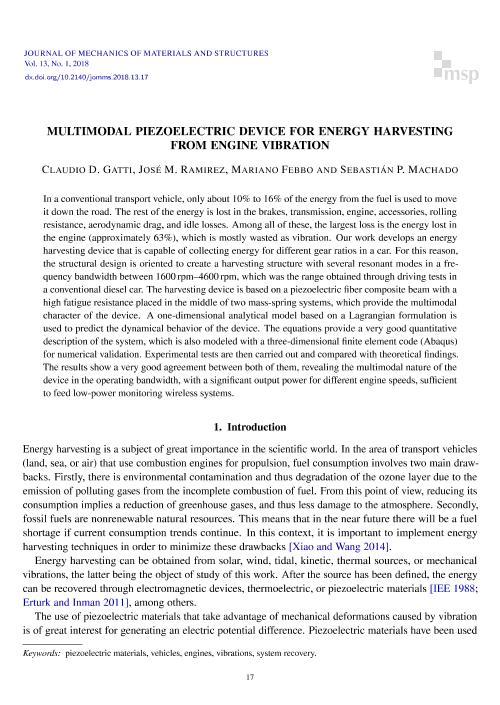Mostrar el registro sencillo del ítem
dc.contributor.author
Gatti, Claudio David

dc.contributor.author
Ramirez, Jose Miguel

dc.contributor.author
Febbo, Mariano

dc.contributor.author
Machado, Sebastián Pablo

dc.date.available
2020-01-10T16:00:12Z
dc.date.issued
2018-04-07
dc.identifier.citation
Gatti, Claudio David; Ramirez, Jose Miguel; Febbo, Mariano; Machado, Sebastián Pablo; Multimodal piezoelectric device for energy harvesting from engine vibration; Mathematical Science Publ; Journal of Mechanics of Materials and Structures; 13; 1; 7-4-2018; 17-34
dc.identifier.issn
1559-3959
dc.identifier.uri
http://hdl.handle.net/11336/94299
dc.description.abstract
In a conventional transport vehicle, only about 10% to 16% of the energy from the fuel is used to move it down the road. The rest of the energy is lost in the brakes, transmission, engine, accessories, rolling resistance, aerodynamic drag, and idle losses. Among all of these, the largest loss is the energy lost in the engine (approximately 63%), which is mostly wasted as vibration. Our work develops an energy harvesting device that is capable of collecting energy for different gear ratios in a car. For this reason, the structural design is oriented to create a harvesting structure with several resonant modes in a frequency bandwidth between 1600 rpm-4600 rpm, which was the range obtained through driving tests in a conventional diesel car. The harvesting device is based on a piezoelectric fiber composite beam with a high fatigue resistance placed in the middle of two mass-spring systems, which provide the multimodal character of the device. A one-dimensional analytical model based on a Lagrangian formulation is used to predict the dynamical behavior of the device. The equations provide a very good quantitative description of the system, which is also modeled with a three-dimensional finite element code (Abaqus) for numerical validation. Experimental tests are then carried out and compared with theoretical findings. The results show a very good agreement between both of them, revealing the multimodal nature of the device in the operating bandwidth, with a significant output power for different engine speeds, sufficient to feed low-power monitoring wireless systems.
dc.format
application/pdf
dc.language.iso
eng
dc.publisher
Mathematical Science Publ

dc.rights
info:eu-repo/semantics/openAccess
dc.rights.uri
https://creativecommons.org/licenses/by-nc-sa/2.5/ar/
dc.subject
ENGINES
dc.subject
PIEZOELECTRIC MATERIALS
dc.subject
SYSTEM RECOVERY
dc.subject
VEHICLES
dc.subject
VIBRATIONS
dc.subject.classification
Mecánica Aplicada

dc.subject.classification
Ingeniería Mecánica

dc.subject.classification
INGENIERÍAS Y TECNOLOGÍAS

dc.title
Multimodal piezoelectric device for energy harvesting from engine vibration
dc.type
info:eu-repo/semantics/article
dc.type
info:ar-repo/semantics/artículo
dc.type
info:eu-repo/semantics/publishedVersion
dc.date.updated
2019-10-22T17:40:56Z
dc.journal.volume
13
dc.journal.number
1
dc.journal.pagination
17-34
dc.journal.pais
Estados Unidos

dc.journal.ciudad
Berkeley
dc.description.fil
Fil: Gatti, Claudio David. Universidad Tecnológica Nacional; Argentina
dc.description.fil
Fil: Ramirez, Jose Miguel. Universidad Tecnológica Nacional; Argentina
dc.description.fil
Fil: Febbo, Mariano. Consejo Nacional de Investigaciones Científicas y Técnicas. Centro Científico Tecnológico Conicet - Bahía Blanca. Instituto de Física del Sur. Universidad Nacional del Sur. Departamento de Física. Instituto de Física del Sur; Argentina
dc.description.fil
Fil: Machado, Sebastián Pablo. Universidad Tecnológica Nacional; Argentina
dc.journal.title
Journal of Mechanics of Materials and Structures

dc.relation.alternativeid
info:eu-repo/semantics/altIdentifier/url/https://msp.org/jomms/2018/13-1/p02.xhtml
dc.relation.alternativeid
info:eu-repo/semantics/altIdentifier/doi/http://dx.doi.org/10.2140/jomms.2018.13.17
Archivos asociados
